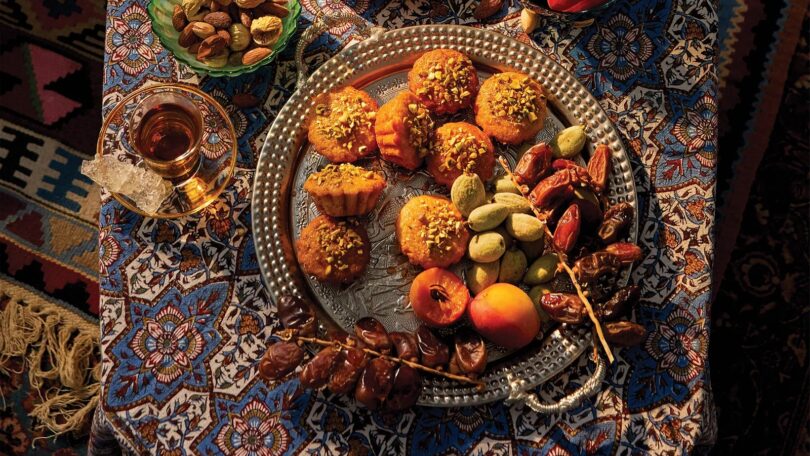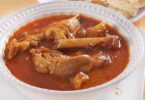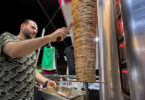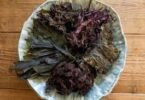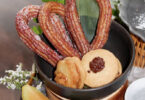Nylah Lee
In the Red Hook neighbourhood of Brooklyn, New York, masterful yoghurt-makers balance sweet and tart in a creamily decadent fermented yoghurt, and preserve and its byproduct of whey. Iranian author, business owner and yoghurt expert, Homa Dashtaki, lies at the heart of the operation, sealing jars of this timeless kitchen staple with a label embellished with an illustration of a white moustache.
In her recent cookbook, Yogurt and Whey: Recipes of an Iranian Immigrant Life, Dashtaki uses her lifelong relationship with yoghurt and whey to tell the story of her culture, faith and relationship with food through her recipes. She emphasises sustainable food production and a battle against wastefulness, instilling these ideals into her 12-year-old yoghurt and whey business, The White Mustache, named for the facial hair of Dashtaki’s earliest kitchen companion: her father.
[jump to recipe]The White Mustache has remained steadfast in its goal of expanding the market for whey, in order to reduce waste. Rather than discard the whey, Dashtaki and her team bottle the highly nutritious yellow-green liquid and urge customers to use it for smoothies, meat marinades and brines and post-workout hydration. The company is even looking into producing whey chips for pets.
Growing up in Iran, her family always made yoghurt from scratch. It functioned as the basis for nearly all meals – sweet or savoury – at any time of day. Dashtaki recalls how conversations over boiling milk fostered a deeper relationship with her father, and, when she immigrated to the United States in 1987, with the small Zoroastrian community that she found in Southern California.
“Yoghurt forces you to slow down. It takes a long time for the milk to boil – and an even longer time for the milk to cool. And in that time, everything feels better,” she explained. “Yoghurt was the excuse for this togetherness, the result of longing to connect and rebuild some semblance of communal village activities around food that we’d been yearning for ever since we left Iran.”
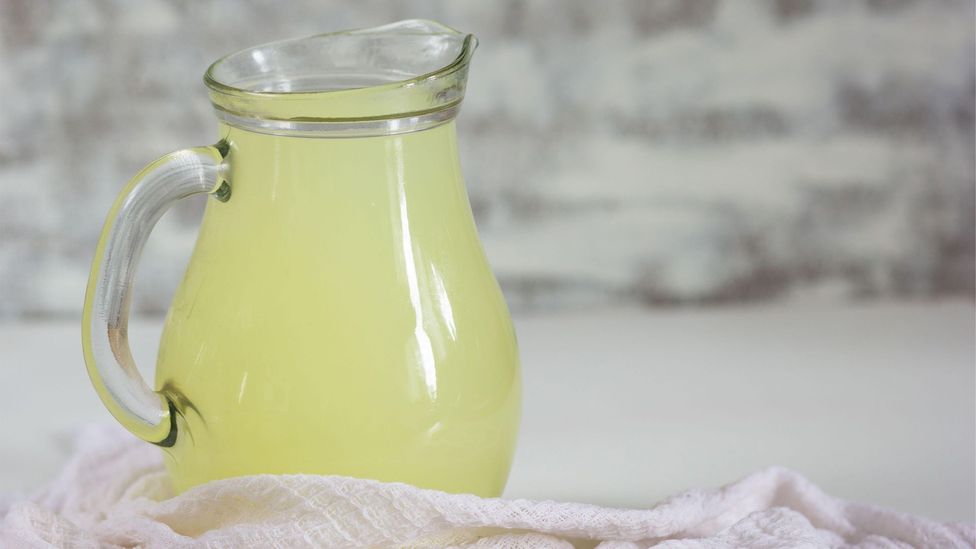
The White Mustache has remained steadfast in its goal of expanding the market for whey, in order to reduce waste. (Credit: Tatiana Gorbunova/Alamy)
For Dashtaki, the lessons in patience, gratitude and focus learned from yoghurt and its resulting recipes keep her from “losing her whey”.
One of these recipes is Cake Yazdi, a moist yet crumbly yoghurt cake reminiscent of her childhood spent in the desertic Yazd province of Iran. Yazd is the birthplace of the dessert, sits in the centre of the country, and is one of the last remaining hubs of Zoroastrianism.
As a Zoroastrian who grew up in one of the clusters of Zoroastrian villages in Yazd, Dashtaki’s relationship with food is intertwined with her faith. In Dashtaki’s words, “Zoroastrian living, in the deserts of Yazd, is dictated by the crops, the weather, the availability of water and how many sheep can be sold or slaughtered. These factors informed our cuisine, and the festivals and celebrations that mark our calendar.”
This farm-to-table culture taught Dashtaki to consider every use of a product before discarding it. In such an environment, a product as versatile as yoghurt could be used to tenderise a savoury meat dish, moisten a dessert or be enjoyed on its own.
Yoghurt, cardamom and rose water are all rich Iranian culinary traditions baked into the Yazd delicacy. These elements evoke a strong sense of nostalgia for Dashtaki, leading her to embark on a seven-year journey to perfect her beloved Cake Yazdi.
“There’s something about Cake Yazdi that tastes like delicious desert nights air. It’s light but it’s dry in the moistest way possible,” she said.
Dashtaki was initially reluctant to recreate the recipe for fear of “getting it wrong”, though she decided to proceed anyway due to her reverence for the dish. It was important for Dashtaki to replicate not only its flavours, but the sentimental feeling that should chase each bite.
“I didn’t want to touch that recipe, [it] had nostalgia written all over it. I was like, ‘If I can’t recreate it – the shame on my family, and the sadness that I would feel over getting it wrong.” Dashtaki struggled to pinpoint the recipe largely because her family never made the dessert at home, so she aimed to construct a Cake Yazdi comparable to that of the Yazd bakeries from her childhood.
“I kept getting it wrong. I couldn’t get the right recipe. But [One day] my aunt’s daughter-in-law gave me a secret family recipe that she got from my aunt, and I was like, ‘Oh, this is going to be it’. For many years, that version of the recipe was the Cake Yazdi recipe that was [going to be] in the book. And I gave it a ton of authority because of the source. But it just didn’t taste right. Then I [thought], ‘Do I have the arrogance to not only mess with my aunt’s recipe, but also this very traditional cake that I have such a nostalgic feelings for?’ And apparently I did.”
She knew certain parts of the dish to be unyielding, like the fluted tart pan that gives each cake its shape, or its perfect complement of black tea (prepared by way of the Persian samovar). However, the earliest versions of her recipe were uncharacteristically yoghurt-less. When she trusted her own instinct and included the creamy binding agent, she discovered that it is instrumental to tenderising the rice flour and perfecting the dessert’s moist yet crumbly texture.
“Finally letting the yoghurt lead the way and become an ingredient in the cake was very helpful. Not using honey but sugar was also very helpful,” she said. In addition, she confronted her heavy-handedness with rosewater and cardamom and adjusted the recipe accordingly. Staples in the Iranian kitchen, these two ingredients are meant to provide a subtle hint of flavour, not overpower the dish.
Fortunately, Dashtaki’s arduous work resulted in a richly dense Cake Yazdi, fully approved by the childhood friends who attach the same nostalgia to the dish as she does.
“There is no review, there is no critic who could top this feeling,” declared Dashtaki in response to her recipe’s success.
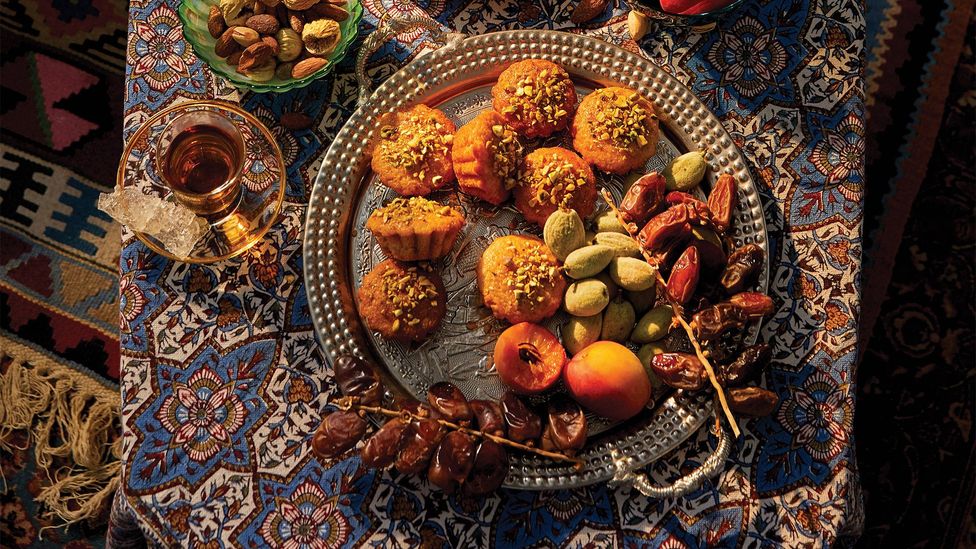
Homa Dashtaki’s Cake Yazdi (Credit: Chris Simpson)
Cake Yazdi
By Homa Dashtaki
Makes 12 individual cakes
Method
Step 1
Preheat the oven to 175C/350F with a rack in the middle position. Grease a 12-cup muffin tin with butter. Sift the plain flour, rice flour, baking powder, bicarb soda, salt and cardamom into a small bowl. Whisk thoroughly till fully combined. Set aside.
Step 2
In a separate small bowl, whisk the egg whites until stiff peaks form; set aside. In a large bowl, whisk the egg yolks and sugar until creamy, 2 to 3 minutes. Mix in the melted butter, yoghurt and rose water and gently whisk until smooth, another 2 minutes.
Step 3
Slowly add the dry ingredients to the wet and mix until fully integrated. Add the egg whites until you have a uniform mixture, gently folding to not deflate the eggs. Fold in the pistachios.
Step 4
Divide the batter among the muffin cups, filling ¾, full. Bake until the tops are browned, and a toothpick inserted in the centre comes out clean, about 25 minutes.
Step 5
Let the cakes cool completely before unmoulding them. Serve with tea. Store any leftovers in an airtight container at room temperature for up to three days.
Tip
These cakes are traditionally baked in fanned muffin tins, making individual tea cakes. Standard muffin tins can also be used.
Courtesy: BBC

